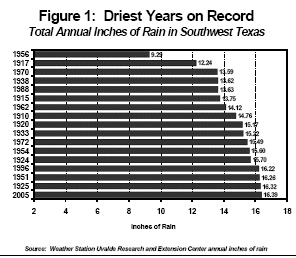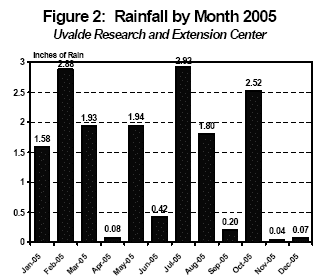Click here for the Acrobat version of this publication.
AG-ECO NEWS
Vol. 22, Issue 01, January 04, 2006
Jose G. Peña
Extension Economist-Management
2005 17th Driest Year on Record
2005 ended as the 17th driest year on record in southwest Texas, (See Figure 1) close behind 1925, 1951, and 1996. The 16.39 inches of rain recorded at the Uvalde Research and Extension Center for 2005 would only beat 1925’s 16.32 inches, 1951’s 16.26 inches and 1996’s 16.22 inches, by a very small amount but with an over 100 year annual average of 24.34, rainfall during 2005 was only about two-thirds of the long term annual average.

While California experienced some of the wettest periods on record, Texas, especially southwest Texas, experienced some of the driest periods on record. The Nov.-Dec. ’05 period in southwest Texas ended as the 4th driest on record and the April ’05-to-Dec. period was the 7th driest on record. (See Figure 2)
 The year opened with a mild, open (lots of sunshine) spring with above average early spring rain which helped produce near record yields of most spring vegetable and some row crops, such as cotton in parts of Texas. Carry-over moisture from 2004 was excellent since 2004 ended as the 24th wettest year on record with 30.55 inches of rain. Now, record and near record high temperatures in the mid 80°F’s, accompanied by dry winds are desiccating surfaces, aggravating the dry spell and increasing agricultural production risk. While 2005 will go down in history as a very difficult year for agricultural production in most of Texas, especially southwest Texas, 2006 is beginning with substantially increased risk for agricultural production.
The year opened with a mild, open (lots of sunshine) spring with above average early spring rain which helped produce near record yields of most spring vegetable and some row crops, such as cotton in parts of Texas. Carry-over moisture from 2004 was excellent since 2004 ended as the 24th wettest year on record with 30.55 inches of rain. Now, record and near record high temperatures in the mid 80°F’s, accompanied by dry winds are desiccating surfaces, aggravating the dry spell and increasing agricultural production risk. While 2005 will go down in history as a very difficult year for agricultural production in most of Texas, especially southwest Texas, 2006 is beginning with substantially increased risk for agricultural production.Forage availability is below average. Ranchers significantly reduced their herds in the mid-90’s as a result of a similar dry spell and the region remains at significantly lower stocking rates. It takes a long time to recover from a drought. While record high prices for cattle and good markets for many other livestock products, increased the estimate of total gross livestock income, increased production costs, in the form of significantly increased supplemental nutrition requirements and high energy costs, will lower the estimate of net ranch income. Attractive markets for livestock may encourage restocking, but unless it rains very soon, it appears that restocking would not be profitable in 2006. Hunting and hunter activities have dominated ranching activities, and continue to provide an essential part of ranch income.
Appreciation is expressed to Dr. Rick Machen, Associate Professor & Extension Livestock Specialist for his contribution and to review this article.
